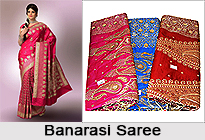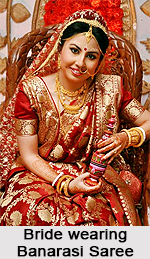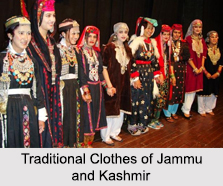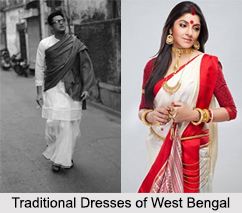 Banarasi Silk is a fine variant of silk originating from the city of Varanasi in Uttar Pradesh. The city is also called "Benaras". Saree woven from this fine silk, known as a Banarasi Silk Saree is very famous all over India and across the world. Being one of the major places of producing silk sarees, Varanasi is the hub of creating Banarasi silk sarees. The traditional Banarasi sarees are among the finest sarees in India and are known for their gold and silver brocade or zari, fine silk and opulent embroidery. The traditional Banarasi saree is the ideal bridal wear for the Indian brides. Banarasi sarees are mostly worn by Indian women on important occasions such as when attending a wedding.
Banarasi Silk is a fine variant of silk originating from the city of Varanasi in Uttar Pradesh. The city is also called "Benaras". Saree woven from this fine silk, known as a Banarasi Silk Saree is very famous all over India and across the world. Being one of the major places of producing silk sarees, Varanasi is the hub of creating Banarasi silk sarees. The traditional Banarasi sarees are among the finest sarees in India and are known for their gold and silver brocade or zari, fine silk and opulent embroidery. The traditional Banarasi saree is the ideal bridal wear for the Indian brides. Banarasi sarees are mostly worn by Indian women on important occasions such as when attending a wedding.
Designs of Banarasi Saree
The special characteristics of Banarasi Sarees are Mughal inspired designs such as intricate intertwining floral and foliate motifs, "Kalga and Bel", a string of upright leaves called `Jhallar` at the outer, edge of border is a characteristic of these sarees. Other features are gold work, compact weaving, figures with small details, metallic visual effects, pallus, jaal and mina work. The sarees are made of finely woven silk and are decorated with intricate design and, because of these engravings, are relatively heavy.
The designs are studded with the flakes of gold and silver that represent the influence of ancient Mughal patronage. The traditional Banarasi sarees are basically made of pure and fine silk that used to be imported from China. Of late the fine silk comes from South India mainly from Bengaluru. The designs were elaborate and intricate as they were the royal attires.
Origin of Banarasi Saree
The earliest mention of the brocade and Zari textiles of Banaras is found in the 19th century. With the migration of silk weavers from Gujarat during the famine of 1603, it is likely that silk brocade weaving started in Banaras in the 17th century and developed in excellence during the 18th and 19th century. During the Mughal period, around 14th century, weaving of brocades with intricate designs using original gold and silver threads became the specialty of Banaras and were used by the people of royal families. Gradually, the zari and simple threads that resemble the original gold and silver threads came into reputation.
With the migration of silk weavers from Gujarat during the famine of 1603, it is likely that silk brocade weaving started in Banaras in the 17th century and developed in excellence during the 18th and 19th century. During the Mughal period, around 14th century, weaving of brocades with intricate designs using original gold and silver threads became the specialty of Banaras and were used by the people of royal families. Gradually, the zari and simple threads that resemble the original gold and silver threads came into reputation.
Types of Banarasi Saree
Banarasi sarees comes in four varieties that are found in the local market. There are following four basic varieties of Banarasi silk saree:
•Pure Silk Saree (Katan)
•Organza Saree (Kora), with Zari And Silk
•Georgette Saree
•Shattir Saree
Depending on the intricacy of its designs and patterns, a saree can take from 15 days to a month and sometimes up to 6 months to complete.





















